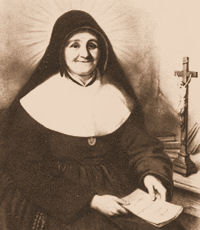Make your gift today!
Help keep Catholics around the world educated and informed.
Already donated? Log in to stop seeing these donation pop-ups.
Lent: April 8th
Tuesday of the Fifth Week of Lent
Other Commemorations: St. Julie Billiart, Virgin (RM)
» Enjoy our Liturgical Seasons series of e-books!
Mortification and self-denial are indispensable means of acquiring strength of will and virtuous habits, and of preserving the life of the soul.
According to the 1962 Missal of St. John XXIII the Extraordinary Form of the Roman Rite, in some places today is the feast of St. Julie Billiart, a French religious who founded, and was the first Superior General of, the Congregation of the Sisters of Notre Dame de Namur.
Meditation - The Eloquence of Jesus' Silence
How singularly majestic must have been the eloquence of Jesus, when as a boy He sat among the doctors of the law in the temple, or when He thrilled the multitudes, commanded the winds and waves, and put to flight diseases and demons and death itself! Yet, perhaps nowhere else did the majesty of His eloquence reveal itself, as it did in that heroic calm and consistent silence, which reached its climax in the three hours of His agony.
But what should strike us most forcibly, and yet most sweetly, is the interior silence of Jesus, the silence of His innermost soul and heart, of His human passions, of His feelings and thoughts and fancies. Recall the word of Jesus, that from the heart come forth evil works, bitter zeal, and false testimonies and blasphemies (Matt. 15:19); and then dwell on His own strikingly consistent example of quashing all bitterness and quenching all the fires of passion, and of refraining from impatience, anger, and retaliation, even when tongues all around were busy kindling fires of hateful calumnies against His truest self-knowledge and wounding His livest self-respect.
Hence, pray that you may see deep into the interior soul of Jesus, there to realize the true majesty and marvelous eloquence of the silence of His lips and tongue, the silence which was the fruit of His charity and of the interior peace and perfection of right order that ever reigned within the sanctuary of His heart, the silence which was the precious fruit of the obedience and humility in His absolute abandonment to the mysterious providence of His Father in heaven.
Excerpted from Our Way to the Father, Rev. Leo M. Krenz, S.J.
St. Julie Billiart
 Saint Julie was a woman completely immersed in God’s love and goodness, even in the midst of great suffering. She was a woman of vision who responded to the needs of the suffering world around her.
Saint Julie was a woman completely immersed in God’s love and goodness, even in the midst of great suffering. She was a woman of vision who responded to the needs of the suffering world around her.
Born in Cuvilly, France, on July 12, 1751, Julie lived a humble life in a loving family. She was a woman of serenity, despite the great personal suffering she endured. The Billiart family survived many hardships, including the deaths of several children. When Julie was 16, she went to work to help support her family. At the age of 23 she became paralyzed by the trauma of a shooting that was aimed at her father. She spent more than 20 years confined to her bed, unable to care for even her most basic needs.
Besides her physical pain, Julie suffered religious persecution, lived in hiding as a refugee. Throughout her suffering, she steadfastly trusted in God’s goodness. At the age of 53, Julie and her very good friend, Françoise Blin de Bourdon, along with two other women, made their vows as Sisters of Notre Dame in Amiens, France. A variety of difficult circumstances caused her to move her congregation to Namur, Belgium, several years later. Today these sisters are known as the Sisters of Notre Dame de Namur. Julie’s spirit and charism also influenced the Sisters of Notre Dame of Amersfoort, The Netherlands, as well as our own congregation of the Sisters of Notre Dame, which began in Coesfeld, Germany.
Julie reached out to the poor and forgotten, she brought comfort and hope to those around her, she encouraged faith in the seeking and the lost. More than anything else, she was a witness to the deep, loving goodness of God. Her motto and mantra was: “Oh, how good God is!” In 1969 Julie was named a saint by the Catholic Church. The impact that Saint Julie had on the world continues through the life and ministry of the sisters who share in her heritage.
—Excerpted from The Sisters of Notre Dame
Patronage: against poverty; bodily ills; impoverishment; poverty; sick people; sickness
Highlights and Things to Do:
- Read more about St. Julie:
- The Sisters of Notre Dame de Namur are still active.






